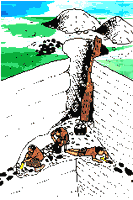
Flint mine - pits dug into the chalk
of the Artois hills.
|
What archaeologists have found
Early humans first reached this area from Africa
about 500,000 years ago. The oldest traces of these
hunter-gatherers in the region were found at Wimereux.
Early men were nomads, following herds of wild animals
and seeking edible plants as part of their struggle to
survive. They left few traces apart from the flints, bones
and antlers they used as tools.
Flint mines
225,000 years ago, men were skilled at making the
best tools and weapons from flints - hard rock nodules found
in layers in the chalk. Flints were mined in shallow pits
dug into the chalk hills both sides of the Channel, hammered
and flaked into axe-heads, spear-tips, arrow-heads, etc.,
fitted to wood handles, and traded with other areas.
Last Ice Age
18,000 years ago, at the height of the last big Ice
Age, ice sheets covered everything north of the Thames. It
was so cold in north France and Kent that few humans
remained. Even in summer, the area was a soggy wasteland -
like Siberia or the Canadian tundra today.
|
|
Stone Age man returned as the area warmed up after the
last big Ice Age. 8,000 years ago those in Britain
were cut off from those in France by the forming
of the English Channel. The rising sea level forced
people to live in the hills, which with warmer weather
thrived with woods and game animals.
First farmers
8,000 years ago people came from northern Europe
bringing ideas from the Middle East about sowing seeds and
growing crops (wheat and barley); and keeping dogs and
animals for meat (pigs, cattle and sheep). They lived in
thatched wooden huts. By 5,500 years ago there were
farming settlements over much of the chalk hills, and large
areas of woodland had been cleared. These communities
developed tribal societies; they left standing stones which
could have had religious significance; buried their warrior
leaders in tombs with "grave goods" (tools, weapons, food
and jewels they might need in the afterlife); and built
forts on hilltops to defend their people and animals against
attack by other tribes.
|
 Dover
Museum's "Bronze Age boat" - shipwrecked 3,000 years ago
near the white cliffs of Dover Dover
Museum's "Bronze Age boat" - shipwrecked 3,000 years ago
near the white cliffs of Dover
|
Bronze Age
4,500 years ago people brought skills of
smelting copper from the mountains of central Europe. They
made jewellery, then learned to add tin to make a harder
alloy called bronze - useful for better, sharper axes and
knives. They also learned how to weave woollen cloth
Iron Age tribes either side of the
Channel
2,750 years ago (750 BC) people brought iron-working
skills to the region from southern Europe. Iron was harder
than bronze, and iron-tipped ploughs helped farmers clear
and plough more woodland for crops.
|
|
Celts and Romans
2,500 years ago (500 BC) warlike Celtic
tribes settled in the area from central Europe. They were
ruled by kings and queens, and built bigger hilltop
strongholds to defend their wealth and people as tribal wars
over land grew fiercer. These were the people who the
Romans met and conquered in first
France then Britain.
|


 Dover
Museum's "Bronze Age boat" - shipwrecked 3,000 years ago
near the white cliffs of Dover
Dover
Museum's "Bronze Age boat" - shipwrecked 3,000 years ago
near the white cliffs of Dover